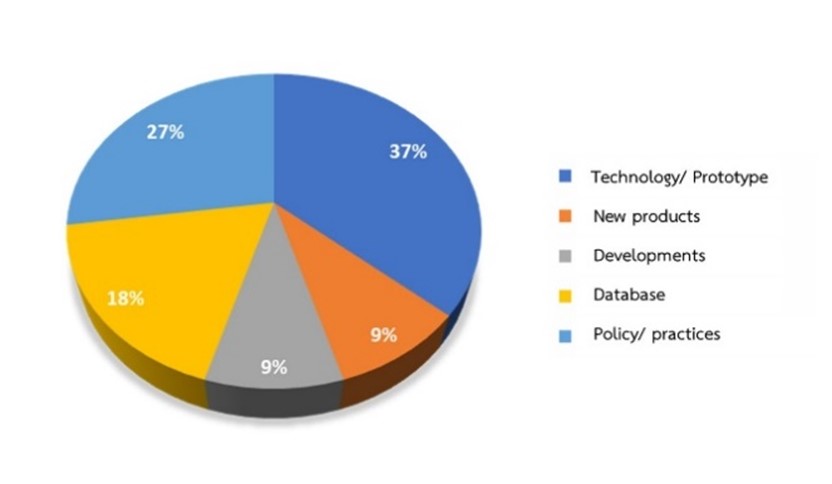Outcomes and Impacts of Research on Waste Management in Thailand in the Fiscal Years 2020-2021
Keywords:
Research Impact, Waste Management, Environmental ImpactAbstract
Background and Objectives: Investment in research and development (R&D) is a critical function of government in driving multifaceted national development. Given the constraints of public budgets, R&D expenditure should be efficiently utilized to maximize societal welfare. This study aimed to evaluate the outputs and outcomes of a waste management research program (Zero Waste) to determine its economic and environmental impacts on the society.
Methodology: Research impact pathway, project inputs, outputs, outcomes, and impacts of the whole research program were evaluated. An in-depth research impact analysis of the 5 case studies were also conducted, analyzing the economic surplus generated from the utilization of the research.
Results: The research program received funding from the National Research Council of Thailand during the fiscal years 2020-2021, with a total allocation of 153.11 million Baht. The program efficiently allocated resources to achieve its objectives, which align with the national environmental strategies. However, only a subset of research projects demonstrated potential for generating significant impacts, with constraints in the utilization of research outputs, indicating a low level of sustainability in research investment. All selected research projects yielded positive net present values that justified the research investment, with the highest net benefit of THB 22.7 million. Research projects across different sub-fields produced varying proportions of economic and environmental impacts, reflecting the degree of public good characteristics of the research outputs.
Recommendations: Program Management Units (PMUs), especially those involving the environmental research domain, should focus on measures that enhance research utilization and knowledge transfer. This is particularly important for research projects generating high environmental impacts with greater positive externalities than research with relatively higher economic impacts, which tend to have higher adoption rates. To improve the utilization of these research findings in public policy domains, concrete mechanisms are necessary to create clear linkages with end-users, such as policymakers or relevant government agencies.
References
Budget Bureau, 2024, Act Budget for Fiscal Year 2024, Budget Bureau [Online], Available: https://www.bb.go.th/topic-detail.php?id=16627&mid=545&catID=1448. [19 September 2024] (In Thai)
Goralnik, L. and Nelson, M.P., 2012, “Anthropocentricism,” in Encyclopedia of Applied Ethics, 2nd ed., Elsevier, Amsterdam.
Varian, H., 2010, Intermediate Microeconomics, W.W. Norton and Company, New York, 739 p.
Bockstael, N.E. and FreemanIII, A.M., 2005, “Welfare Theory and Valuation” pp. 517-570, in K.G. Maler and J.R. Vincent (Eds.), Handbook of Environmental Economics, Vol. 2, Elsevier, Amsterdam, 642 p.
Weißhuhn, P., Helming, K., and Ferretti, J., 2018, “Research Impact Assessment in Agriculture- A Review of Approaches and Impact Areas,” Research Evaluation, 27 (1), pp. 36-42.
Deloitte Access Economics, 2012, Extrapolated Returns on Investment in NHMRC Medical Research, Australian Society for Medical Research, Canberra, 8 p.
Buxton, M. and Hanney, S., 1996, “How Can Payback from Health Service Research be Assessed,” Journal of Health Service Policy, 1 (1), pp. 35-43.
ACIAR., 2009, A Framework for Assessing of the Impact of Capacity Building, Australian Centre for International Agricultural Research, Australia, 11 p.
Hanley, N. and Barbier, E.B., 2009, Pricing Nature, Edward Elgar Publishing, Massachusetts, 353 p.
Premashthira, A., Kuldilok, K. and Limsombunchai, V., 2023, “Outcomes and Impacts of Investment in Research and Development of Biochemical Energy and Biodegradable Plastics,” Journal of Research and Development, 46 (4), pp. 337-352.
Seneerattanaprayul, J. and Praneetvatakul, S., 2023, “Assessment of Academic Outputs and Outcomes from Medical Science Research,” The Journal of Research and Academics, 7 (3), pp. 161-176.
OECD, 2019, Better Criteria for Better Evaluation (Revised Evaluation Criteria Definitions and Principles for Use), OECD, 13 p.
Vijitsrikamol, V., 2021, Evaluating Research and Development Impacts: Basic Principles and Practices, Knowledge Network Institute of Thailand, Bangkok, 210 p. (In Thai)
Sanglestsawai, S., 2022, Economic Valuation of Natural Resources and the Environment Direct Methods for Measuring Satisfaction, Kasetsart University, Bangkok. (In Thai)
Navrud, S. and Ready, R., 2007, Environmental Value Transfer, Issues and Methods, Springer, Dordrecht, 290 p.
Isvilanonda, S., Pananurak, P. and Praneetvatakul, S., 2015, Assessing the Impact of Research on Agriculture and Agro-industry, Knowledge Network Institute of Thailand. Bangkok, 215 p. (In Thai)
TSRI Thailand Science Research and Innovation, 2020, Manual for Agencies Receiving Budgets from the Science Promotion Fund Research and Innovation Fiscal Year 2020-2022, Zeno Publishing, Bangkok, 95 p. (In Thai)
Longo S., Cellura, M. and Girardi, P., 2020, “Life Cycle Assessment of Electricity Production from Refuse Derived Fuel: A Case Study in Italy,” Science of the Total Environment, 738 (2020), pp. 1-13.

Downloads
Published
How to Cite
Issue
Section
License
Copyright (c) 2024 King Mongkut's University of Technology Thonburi

This work is licensed under a Creative Commons Attribution-NonCommercial-NoDerivatives 4.0 International License.
Any form of contents contained in an article published in Science and Engineering Connect, including text, equations, formula, tables, figures and other forms of illustrations are copyrights of King Mongkut's University of Technology Thonburi. Reproduction of these contents in any format for commercial purpose requires a prior written consent of the Editor of the Journal.

